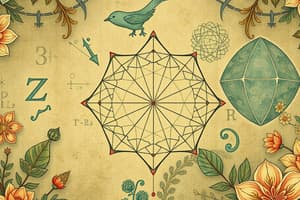Podcast
Questions and Answers
What does the acronym PEMDAS represent in mathematics?
What does the acronym PEMDAS represent in mathematics?
- Parentheses, Exponents, Division, Addition, Subtraction, Multiplication
- Parentheses, Exponents, Multiplication, Addition, Division, Subtraction
- Product, Exponents, Multiplication, Division, Addition, Subtraction
- Parentheses, Exponents, Multiplication, Division, Addition, Subtraction (correct)
Which of the following defines a function?
Which of the following defines a function?
- A collection of numbers only.
- A relation that assigns multiple outputs to a single input.
- A mathematical statement of equality.
- A relation that assigns each input exactly one output. (correct)
What is the Pythagorean theorem used to solve?
What is the Pythagorean theorem used to solve?
- Side lengths of right triangles. (correct)
- Areas of rectangles only.
- Volume of three-dimensional shapes.
- The relationship between angles in a circle.
Which of the following statements is true about prime numbers?
Which of the following statements is true about prime numbers?
What is the purpose of statistical inference?
What is the purpose of statistical inference?
What does the term 'union' refer to in set theory?
What does the term 'union' refer to in set theory?
Which concept links differentiation and integration?
Which concept links differentiation and integration?
What type of proof is characterized by assuming the opposite of what you want to prove?
What type of proof is characterized by assuming the opposite of what you want to prove?
Flashcards are hidden until you start studying
Study Notes
Key Areas in Mathematics
-
Arithmetic
- Basics: Addition, subtraction, multiplication, division.
- Properties: Commutative, associative, distributive laws.
- Order of operations: PEMDAS (Parentheses, Exponents, Multiplication and Division, Addition and Subtraction).
-
Algebra
- Variables: Symbols representing numbers.
- Expressions: Combinations of numbers, variables, and operations.
- Equations: Mathematical statements of equality; solving for unknowns.
- Functions: Relations between sets that assign each input exactly one output.
-
Geometry
- Basic shapes: Circles, triangles, squares, rectangles, polygons.
- Properties: Area, perimeter, volume.
- Theorems: Pythagorean theorem, properties of angles.
- Coordinate geometry: Graphing on the Cartesian plane.
-
Trigonometry
- Functions: Sine, cosine, tangent, and their reciprocals.
- Right triangles: Relationships between angles and sides.
- Unit circle: Understanding angles in terms of radians.
- Applications: Solving triangles, oscillations, waves.
-
Calculus
- Derivatives: Measure of how a function changes as its input changes; slope of a curve.
- Integrals: Measure of the area under a curve; accumulation of quantities.
- Fundamental theorem of calculus: Links differentiation and integration.
- Applications: Motion, optimization problems, area between curves.
-
Statistics
- Data representation: Mean, median, mode, range.
- Probability: Basics of likelihood, independent and dependent events.
- Distributions: Normal, binomial, Poisson distributions.
- Inferential statistics: Hypothesis testing, confidence intervals.
-
Mathematical Logic
- Statements: Conditional statements, converse, inverse.
- Quantifiers: Universal and existential quantifiers.
- Logical reasoning: Deductive and inductive reasoning.
-
Number Theory
- Prime numbers: Numbers greater than 1 with no divisors other than 1 and themselves.
- Divisibility rules: Methods to determine factors.
- Modular arithmetic: Arithmetic for cyclic patterns, such as clock arithmetic.
-
Set Theory
- Sets: Collections of distinct objects.
- Operations: Union, intersection, difference, complement.
- Venn diagrams: Visual representation of sets.
-
Mathematical Proofs
- Types: Direct proof, proof by contradiction, induction.
- Structure: Definitions, statements, logical deductions.
Important Concepts
-
Mathematical Methods
- Problem-solving: Strategies such as working backward and drawing diagrams.
- Estimation: Approximating values to make calculations easier.
-
Applications of Mathematics
- Real-world uses: Engineering, physics, finance, computer science.
- Importance: Critical thinking, logical reasoning, analytical abilities.
Arithmetic
- Basic operations: Addition, subtraction, multiplication, and division
- Properties: Commutative, associative, and distributive laws guide operations
- Order of operations: Follow PEMDAS (parentheses, exponents, multiplication/division, addition/subtraction) for accurate calculations
Algebra
- Variables: Symbols representing unknown quantities
- Expressions: Combinations of numbers, variables, and operations
- Equations: Mathematical statements of equality used to solve for unknown variables
- Functions: Relationships where each input has exactly one output
Geometry
- Basic shapes: Circles, triangles, squares, rectangles, and polygons
- Geometric properties: Area, perimeter, and volume describe a shape's characteristics
- Theorems: Pythagorean theorem relates sides of right triangles
- Coordinate geometry: Representing shapes and understanding their locations on the Cartesian plane
Trigonometry
- Trigonometric functions: Sine, cosine, and tangent relate angles and sides of right triangles
- Right triangles: Relationships between angles and sides are fundamental
- Unit circle: Understanding angles in terms of radians with x- and y-coordinates
- Applications: Solving triangles, analyzing periodic phenomena (e.g, oscillations, waves)
Calculus
- Derivatives: Measure how a function's output changes as its input changes, represented by the slope of a curve
- Integrals: Determine the accumulation of quantities or the area under a curve
- Fundamental theorem of calculus: Links differentiation and integration, essential for calculus
- Applications: Analyzing motion, optimizing design, calculating areas between curves
Statistics
- Data representation: Mean, median, mode, and range summarize data sets
- Probability: Describes the likelihood of events; includes independent and dependent events
- Distributions: Describes the spread of data; common distributions include normal, binomial, and Poisson
- Inferential statistics: Uses samples to make inferences about populations; includes hypothesis testing and confidence intervals
Mathematical Logic
- Statements: Assess the truth or falsity of propositions; include conditional statements, converses, and inverses
- Quantifiers: Universal (all) and existential (some) quantifiers specify the scope of statements
- Logical reasoning: Deductive reasoning derives conclusions from given premises; inductive reasoning makes generalizations based on observations
Number Theory
- Prime numbers: Numbers greater than 1 with only 1 and themselves as divisors
- Divisibility rules: Methods to determine if one number is divisible by another
- Modular arithmetic: Arithmetic for cyclic patterns, similar to clock arithmetic
Set Theory
- Sets: Collections of distinct objects with common properties
- Operations: Union, intersection, difference, and complement combine sets
- Venn Diagrams: Visual representation of sets and their relationships
Mathematical Proofs
- Types: Direct proof, proof by contradiction, and proof by induction are common methods
- Structure: Include definitions, statements, and logical deductions
Mathematical Methods
- Problem-solving: Strategies include working backward, drawing diagrams, and considering different approaches
- Estimation: Approximating values to make calculations simpler and faster
Applications of Mathematics
- Real-world uses: Engineering, physics, finance, computer science, and more
- Importance: Critical thinking, logical reasoning, and analytical abilities are crucial skills developed through mathematics
Studying That Suits You
Use AI to generate personalized quizzes and flashcards to suit your learning preferences.




